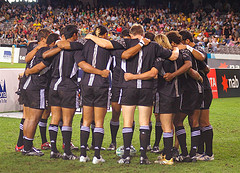 I was at Exeter University on Wednesday listening to Professor John Bessant describe the difference between how innovation used to be, and how it is now. In the TV-industrial complex days, teams worked behind closed doors in order to hide their innovations. The rule was that a company had to have the smartest people working for it.
I was at Exeter University on Wednesday listening to Professor John Bessant describe the difference between how innovation used to be, and how it is now. In the TV-industrial complex days, teams worked behind closed doors in order to hide their innovations. The rule was that a company had to have the smartest people working for it.
Today, it’s the other around. We have what I discovered is called open innovation. It means that a company no longer thinks they have the smartest people working for them. It means that today, a team comprises of the people who can make the project happen, no matter where they are or who they do or don’t work for.
This is how teams work in People-to-People. Finally we’ve realised that sometimes the best person to have in your team works for a competitor – but that’s ok. Sometimes, the smartest person is the customer. Other times, the smartest person to get onboard is across the world and you talk digitally.
B2B, B2C, buyer, supplier, consumer, boss, employee, competitor – all these phrases begin to fade in a People-to-People environment.
Why? Because those terms are tied into the old model that values processes over people. They are about process and paper work, not about people. But today we’re free from what I call factory thinking. Today we recognise that processes are commoditised, knowledge is cheap – but talented people who fit into a team and make things happen are a rare find.
Here’s the rub, though: to have a team that makes things happen, you need to motivate with more non-financial influence that you do financial impact. Because making ideas happen (and not letting those ideas just become unrealised ideals) requires the kind of blood, sweat and tears that wages don’t buy.
Influence is what gets customers to join your team. Influence is what gets people to work, not for money, but for self-actualisation. Influence is what builds a team out of vision.
My Question For You
- How are you using influence to build teams?
Photo with thanks to claytonjayscott.com
Archived Comments
-
http://radsmarts.com Robin Dickinson
Hi Scott.
“How are you using influence to build teams?”
THE ESKIMO’S GUIDE TO TEAM BUILDING
a) Identify the lead husky: the one with all the energy, passion, ideas and ‘blind faith’ who’s happy to haul the sled to the vision (i.e. do the heavy lifting) and lead the pack (ego very important);
b) Recruit support huskies: the one’s who love the sound of the idea/vision, who are happy to follow, and will bark in with the occasional idea;
c) Jump on sled and guide direction. NB: avoid ravines, polar bears and aggressive penguins and keep team fed and on-track. (otherwise known as ‘back-of-room facilitation’).
Just one way – from an old Eskimo.

Best to you, Robin

-
Scott Gould
I like this. Im a little fried to add to it – but the analogy is good and gives me some good stuf to thinkt hru
Comments